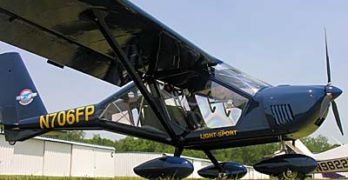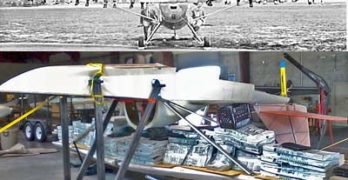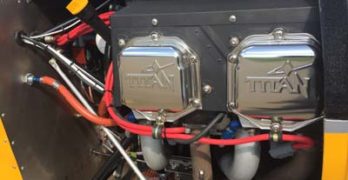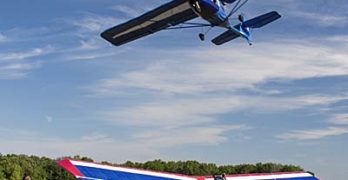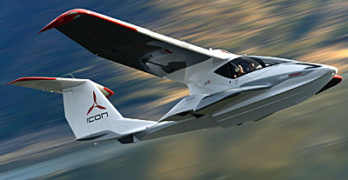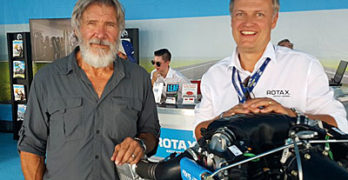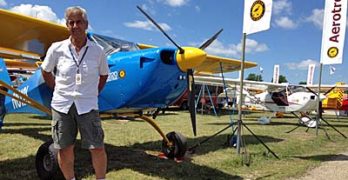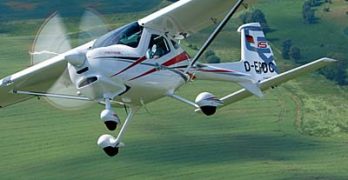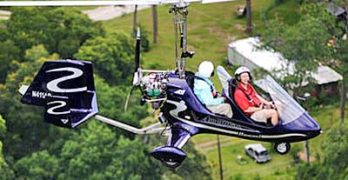Coming up NEXT WEEK! — September 8-9-10, 2016 — is the Midwest LSA Expo. I encourage you to make plans now to attend at least one of the days the event runs. Based on past years, a good number of aircraft will be available. Speaking to their representatives and taking a demo flight is as easy as it gets at any airshow. More info: Midwest LSA Expo.
A22 Importer Dennis Long said that people refer to his Aeroprakt side-by-side two seater as “the see-through airplane.” Certainly, this Light-Sport Aircraft has more clear plastic in its cockpit covering than any other LSA. It’s no surprise that this entry has some of the best visibility you can find in any aircraft. What you may not see while you’re looking through it is the size. A22 has a cabin about 50 inches wide making it one of the roomiest models available.
Search Results for : MG 21
Not finding exactly what you expected? Try our advanced search option.
Select a manufacturer to go straight to all our content about that manufacturer.
Select an aircraft model to go straight to all our content about that model.
Torture Testing… Let Freedom Wing!
Most pilots never probably have witnessed the testing a wing endures before designers and regulators will sign off on it, signaling that it has been adequately stressed so that pilots can depend on it. I’ve had the chance to see several such tests and will state that it is two things: demanding and, well …boring (unless something breaks).
Of course, I don’t mean to demean the hard work it takes. Look at the images in this article and you can see that just to set up a wing for testing can involve literally days if not weeks of work. A fixture, sometimes called a “strongbox,” must be built or obtained. An actual wing must be affixed to the structure. Weights in some form — and a lot of them — must be secured to the wing to assure loads are applied in a real simulation; air loads are not uniform across the wing’s span.
Continental Motors Absorbs Titan X-340 Production
Coming up in just over two weeks! — September 8-9-10, 2016 — is the Midwest LSA Expo. I hope your plans include going. Plenty of aircraft are available and taking a demo flight is no easier anywhere. I will look for you on site! More info: Midwest LSA Expo.
Engines have changed a lot over the life of Light-Sport Aircraft. FAA’s new regulation became effective in September 2004. A hard working industry has brought 140 Special LSA models to market …in less than 12 years, one per month for every month (on average) since the rule emerged.
Engines have been similarly prolific.
In the beginning, Rotax‘s 65-horsepower two-stroke 582 was a often selected to power the lighter aircraft of the pre-LSA period. The 9-series engines had gained acceptance much earlier but as LSA got bigger and heavier, their success gave a tremendous push to the popular Austrian engine and it dominates to this day.
Zenith Aircraft — CH-750 Cruzer PILOT REPORT (0914)
Zenith has found a very ripe market with lots of buyers of their kit-only CH-701 or CH-750 models that some refer to as a “Sky Jeep.” These are STOL models with short takeoff and landing. Plenty of people love it but prefer a higher cruise speed for cross country travel. Therefore, welcome to Cruzer. It dispenses with the slotted wings and fat tires. Wheelpanted and using only a single wing strut with a cleaner wing, Cruzer, well … cruises. However, it keeps a very short takeoff and landing and retains the easy flying qualities of the Sky Jeep.
Quicksilver… Going, Going, Gone. Or, Not?
Coming up soon — September 8-9-10, 2016 — is the Midwest LSA Expo. Videoman Dave and I will be present to report on around 50 aircraft on display. I hope you can join us. Get more info: Midwest LSA Expo.
Many times I’ve written that Quicksilver is arguably THE most successful seller of kit aircraft in the world. Some aviators might retort, “No way! Van’s Aircraft is the largest kit builder.” In total kits, at least portions of kits, that’s surely true. Van’s reports more than 20,000 tail kit-type deliveries have been made. Even more impressively, their completions — aircraft fully built and registered with an N or other number — now exceed 9,460 and I would never take away from their success with multiple designs nor would I diminish their highly-regarded business integrity.
Nonetheless, with Quicksilver having delivered more than 15,000 full kits, the vast majority of which were built and flown, they may be the most successful deliverer of complete aircraft kits in history.
Will Third Class Medical Reform Hurt LSA?
One of the most common questions I got at Oshkosh 2016 was the title of this article. I’m only one person with an opinion, but since I work with many airframe producers in the LSA space, I heard this question fairly often, several times from airplane sellers who were curious what other producers thought.
Just shy of five years ago, EAA and AOPA caught the LSA industry off guard by announcing plans to push FAA to drop the Third Class medical. Most LSA professionals likely agree with the basic idea that FAA ought to keep their noses out of the recreational end of aviation. Many feel that the medical requirement has prevented almost no accidents. Nonetheless, this new initiative took aim at the primary reason LSA builders were then selling airplanes like crazy. If you wanted to fly without a medical you had ultralights (Part 103… and still do), or sailplane motorgliders, or Light-Sport Aircraft.
Latest and Greatest LSA from Oshkosh 2016
In a show as vast at EAA’s AirVenture Oshkosh, it is presumptuous to attempt covering everything of interest. What follows are some new aircraft I found in the categories I cover on this website. Other projects were certainly worthy of special note but with the goal of a fast dash through the latest and greatest, I’m keeping this one fairly lean. I’ll cover other developments in subsequent articles.
So, here’s three aircraft you haven’t seen before AirVenture 2016 plus a revised project involving an increasingly popular engine. I’ll start off with a famous guy checking out a famous engine to propel one of my favorite airplanes. We begin our quick review with Lockwood Aircraft‘s AirCam.
Of course, you know his face. When I once heard Harrison Ford speak, he said modestly (paraphrased), “I earn a living making faces.” I never thought of acting in such simple terms, but I accept such skills are part of the job.
Succeeding the Old Fashioned Way: Getting It Right
Media people (like me) flock to airshows looking for the new stories, new airplanes, new avionics, new company developments… whatever is new. Journalists pursue what’s new because they believe that’s what their customers readers want to read (or perhaps because it interests them as a writer). Nevertheless, sometimes the story is what’s not new. Aerotrek, importer of the A240 and A220 has not made major changes to the aircraft.
Why? Simple. The airplanes don’t need to change.*
Aerotrek’s planes are very well built, fly predictably and efficiently, handle nicely and perform near the top of the category at modest operation cost. They are simpler, not fancy carbon fiber, but rely on trusted construction methods using familiar materials. As important as any quality, Aerotreks are modestly priced, affordable to many budgets.
Not breaking new ground means getting familiar ways down pat, honing the building skills and techniques to a fine degree.
Remos GXiS — A Mercedes of LSA
Oshkosh is on! OK, not today. The big show starts tomorrow, but you wouldn’t know it as airplanes are already arriving in droves and the grounds are rapidly filling. Time for EAA’s summer celebration of flight to begin!
Although I’m a longtime regular, today I did something I’ve never done. I flew out of KOSH and then returned. If you’ve never flown into Oshkosh during AirVenture, you may not know what an experience such an arrival can be. This is the world’s busiest airport for one week. Airplanes arrive every few minutes and all of them do so in a unique, follow-the-plane-in-front-of-you method where no pilot uses the radio. Departing was fairly simple. Arriving is always an eye-opening experience.
I did my departure and reentry with Remos PR & Marketing guy Patrick Holland-Moritz, a former German aviation magazine writer. We flew in the brand new Remos GXiS. Flying into Oshkosh was a repeat treat for me, but I think Patrick was blown away by the flowing river of airplanes of all types.
Flying America’s First Homegrown Modern Gyroplane
Once upon a time… gyrocopters were an American invention. Igor Benson was such an important pioneer that many fixed wing pilots refer to all such flying machines as “Bensen gyros.” Starting in the 1950s, he hit on a good combination of ideas that made the new sector flourish… for a time.
Gyros are small rotary winged aircraft that resemble helicopters in some ways — all have a spinning wing above the occupants. However, gyros work by the air moving across the blades of the rotor disk; their rotors are not powered. Most readers likely don’t need a technical discussion. Suffice it to say gyros and helos are far from the same animal no matter how much they might look like one another.
Yet in the last couple decades things began to change, dramatically. Perhaps to accentuate their differences, modern producers prefer “gyroplanes” while the older Bensen types are often referred to as “gyrocopters.” The old and new are different in important ways.
- « Previous Page
- 1
- …
- 50
- 51
- 52
- 53
- 54
- …
- 94
- Next Page »


